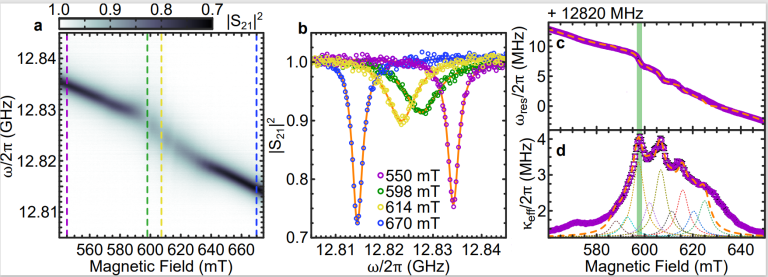EEE research featured in prestigious Journal
5 June 2023
Nature Communications published research by UCL Electronic and Electrical Engineering (EEE) and the London Centre for Nanotechnology (LCN).

Fascinating research led by EEE's Dr. Christoph Zollitsch presents the methodology for detecting spin dynamics in few layers of two-dimensional (2D) van der Waals magnets, with prospects for the detection of single layer spin dynamics.
Significance of research
Magnetic van der Waals materials have seen a huge increase in focus with the realization of fabricating monolayers and consecutive characterisation of the magnetism in them. These materials are highly interesting for spintronics as they promise miniaturisation towards 2D device structures with ultra-fast information processing capabilities.
This was realised by using highly sensitive superconducting microwave resonators able to detect only small numbers of spins. The 2d van der Waals magnetic material was transferred onto such resonators and the spin dynamics were studied by ferromagnetic resonance (FMR). This allowed the team to detect the spin dynamics of micrometre scale Cr2Ge2Te6 (CGT) consisting of only 15 monolayers. The technique was extensively tested on 23 different devices with CGT thickness ranges between 153nm and 11nm and it was found that the magnetic properties were not altered due to the transfer process or the superconducting resonator. Finally, the method used allowed to estimate the magnetic damping for CGT, a key parameter for high frequency spintronics applications.
The work combined techniques and ideas from spintronics and quantum information processing to enable new directions of research and applications for 2D van der Waals magnets. The presented techniques are readily transferable to other materials and will help to develop new experiments focused on fundamental research, as well as new spintronic devices on the nanometre scale for fast information processing.
What does this mean?
The study - a collaboration between EEE, London Centre for Nanotechnology (LCN) at UCL, University of Edinburgh and National University of Singapore - has realised detection of magnon dynamics in ultra-thin van der Waals magnets in the microwave regime. This is highly interesting for fundamental magnetism research as from the Mermin-Wagner theorem a conceptual change in behaviour is expected.
In addition, having established magnon dynamics for ultra-thin (or monolayer) van der Waals magnets via microwave control poses a huge leap towards real-world applications. Modern information processing typically operates at microwave frequencies. The methodology is targeted to operate in this frequency range, and thus presents an ideal platform for engineering novel devices for fast information processing.
Lead author from EEE, Dr. Christoph Zollitsch, states:
“ This project was an extraordinary journey, bringing together multiple international researchers from fields of magnetism and spintronics, as well as quantum information processing. Our collaborative effort made it possible to push the sensitivity boundaries for 2d magnetic van der Waals materials. Our work will enable fascinating new directions for fundamental research and applied science. It was a great experience to see that, initially disparate research areas, can be brought together with great success.
Read the article
"Probing spin dynamics of ultra-thin van der Waals magnets via photon-magnon coupling"
C. W. Zollitsch, S. Khan, V. T. Trung Nam, I. A. Verzhbitskiy, D. Sagkovits, J. O’Sullivan, O. W. Kennedy, M. Strungaru, E. J. G. Santos, J. J. L. Morton, G. Eda and H. Kurebayashi, Nature Comm. 14, 2619 (2023)
Further information
Dr Christoph Zollitsch
Prof. Hide Kurebayashi
Prof. John Morton
 Close
Close

